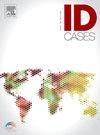Severe disseminated Talaromyces marneffei infection in idiopathic CD4 lymphopenia
IF 1.1
Q4 INFECTIOUS DISEASES
引用次数: 0
Abstract
Idiopathic CD4 lymphopenia (ICL) is a rare non–HIV-related syndrome, characterized by a reduced CD4 T-cell count and a predisposition to various opportunistic infections. However, Talaromyces marneffei (TM) infection has rarely been reported in ICL patients. Here, we report a previously healthy 48-year-old male patient who presented with fever, headache, fatigue, vomiting, and poor appetite. Mycological cultures from blood, bone marrow, liver and spleen were positive for TM. The immunodeficiency evaluation revealed a CD4 T-lymphocyte count of 32 cells/μL, with a negative HIV test. After receiving co-treatment with amphotericin B and voriconazole, the patient showed clinical improvement. At 1-year follow-up, the CD4 T-cell count remained decreased despite the complete resolution of symptoms. The appearance of disseminated TM infection in non-HIV patients should prompt an investigation for the possibility of ICL, as the clinical manifestations can be severe.
特发性CD4淋巴细胞减少症患者严重弥散性曼尼菲塔芳菌感染。
特发性CD4淋巴细胞减少症(ICL)是一种罕见的非hiv相关综合征,其特征是CD4 t细胞计数减少,易患各种机会性感染。然而,在ICL患者中,马尔内菲Talaromyces marneffei (TM)感染的报道很少。在此,我们报告一位先前健康的48岁男性患者,他表现为发烧,头痛,疲劳,呕吐和食欲不振。血液、骨髓、肝脏和脾脏的真菌学培养均为TM阳性。免疫缺陷评估显示CD4 t淋巴细胞计数为32个/μL, HIV检测阴性。经两性霉素B与伏立康唑联合治疗后,患者临床好转。在1年的随访中,尽管症状完全缓解,CD4 t细胞计数仍然下降。当非hiv患者出现弥散性TM感染时,应考虑ICL的可能性,因为其临床表现可能很严重。
本文章由计算机程序翻译,如有差异,请以英文原文为准。
求助全文
约1分钟内获得全文
求助全文

 求助内容:
求助内容: 应助结果提醒方式:
应助结果提醒方式:


